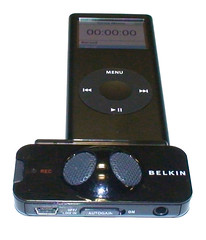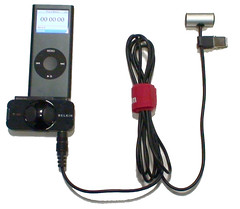ipod Nano and Belkin TuneTalk Stereo review
In a previous post I reviewed the Apple iPod recorder + Belkin TuneTalk Stereo recorder attachment. Since then I have purchased and extensively tested the second generation iPod 8G Nano in combination with the Belkin TuneTalk Stereo.

image by sridgway
As you can see from the photograph the Belkin TuneTalk is designed for the ipod video so it looks a tad wider than the Nano, nevertheless it fits to the connector perfectly and has never given me any troubles during recording.
I have examined the features of the Belkin TuneTalk in my previous post so I won’t repeat it here. I have used the combination of the 8Gig Nano and the Belkin in a wide range of setups and circumstances with great success.
Battery Life
Apart from its size and weight, the main advantage of the Nano compared with the ipod video is battery life. I have been able to record for up to four hours continuously. The battery indicator reads red somewhat prior to the battery being drained and I gather this is due to the large current confusing the battery monitoring system. If I am recording a conference I can charge it up over the lunch break and be back on track for the afternoon session. Offcourse the Belkin also allows you to connect a lead to a usb port and power the Nano while recording
Recording format
The Nano & Belkin combo has the functional capacity to record to the following formats
High Quality – 44000Hz, 16-bit, Stereo uncompressed *.wav format
Low Quality – 22050Hz, 16-bit, Mono uncompressed *.wav format
This is comparable to a range of external recording attachments such as the Extreme Micro Memo or the Griffin Technology iTalk Pro
Memory Capacity
The Nano records in uncompressed *.wav format so the files generated are quite large.
In High Quality mode - 1 hr = approx 800 Mb
In Low Quality mode - 1 hr = approx 160 Mb
With the 8 Gig Nano you have sufficient room to do a whole days recording quite comfortably. I mostly record using the low setting as I typically distribute my podcasts @ 22 Khz, mono, 32 kbs encoding which means all I have to do in post processing is mp3 encoding.
Accessing the recorded files (using windows)
There are 2 ways to access the recorded files on the Nano
Access the files directly from the Nano
The Nano will work as a memory stick so all you need to do navigate to a directory titled “Recordings” and copy the files to a convenient location for post production editing.
Once you have a copy you can then delete the files, this way once iTunes loads it will not copy the files off the Nano into the iTunes libray.

Using iTunes to access the files
If iTunes opens while recordings are present on the Nano you will be prompted to move them to the iTunes library. This moves the recorded files to the root of the music section of your library and will be synchronised to the Nano in the normal fashion.
You can physically find the files on your computer under in the root of the mymusic>iTunes>iTunes Music directory.

You can copy them to another location for post production editing and then delete them from the library using iTunes.

Recording quality
I have used the Belkin/Nano combo in the following contexts and had fabulous results.
Using the internal microphone on the Belkin with auto gain
Using an external visivox SCM VOX lapel mic
Using a mixer with line in on the Belkin
Here is a sample podcast recording using line out from a mixer
http://talkingvte.blogspot.com/2007/03/talking-vte-episode-3.html

image by sridgway
Here is a sample recording using external visivox SCM VOX lapel mic
http://talkingvte.blogspot.com/2006/12/library-20-getting-from-here-to-there.html

image by sridgway
Overall I have been very impressed with the results from the Nano/Belkin Tune Talk combination, it is now what I recommend to teacher who want to purchase a field recording unit for podcasting. Hopefully Belkin will bring out a unit better suited to the smaller profile of the Nano. Micromemo has released a unit specifically for the Nano, however for the moment I still prefer the Belkin.
Technorati Tags: podcasting ipod nano tlnw tunetalk nswlearnscope07 clcommunity

image by sridgway
As you can see from the photograph the Belkin TuneTalk is designed for the ipod video so it looks a tad wider than the Nano, nevertheless it fits to the connector perfectly and has never given me any troubles during recording.
I have examined the features of the Belkin TuneTalk in my previous post so I won’t repeat it here. I have used the combination of the 8Gig Nano and the Belkin in a wide range of setups and circumstances with great success.
Battery Life
Apart from its size and weight, the main advantage of the Nano compared with the ipod video is battery life. I have been able to record for up to four hours continuously. The battery indicator reads red somewhat prior to the battery being drained and I gather this is due to the large current confusing the battery monitoring system. If I am recording a conference I can charge it up over the lunch break and be back on track for the afternoon session. Offcourse the Belkin also allows you to connect a lead to a usb port and power the Nano while recording
Recording format
The Nano & Belkin combo has the functional capacity to record to the following formats
High Quality – 44000Hz, 16-bit, Stereo uncompressed *.wav format
Low Quality – 22050Hz, 16-bit, Mono uncompressed *.wav format
This is comparable to a range of external recording attachments such as the Extreme Micro Memo or the Griffin Technology iTalk Pro
Memory Capacity
The Nano records in uncompressed *.wav format so the files generated are quite large.
In High Quality mode - 1 hr = approx 800 Mb
In Low Quality mode - 1 hr = approx 160 Mb
With the 8 Gig Nano you have sufficient room to do a whole days recording quite comfortably. I mostly record using the low setting as I typically distribute my podcasts @ 22 Khz, mono, 32 kbs encoding which means all I have to do in post processing is mp3 encoding.
Accessing the recorded files (using windows)
There are 2 ways to access the recorded files on the Nano
Access the files directly from the Nano
The Nano will work as a memory stick so all you need to do navigate to a directory titled “Recordings” and copy the files to a convenient location for post production editing.
Once you have a copy you can then delete the files, this way once iTunes loads it will not copy the files off the Nano into the iTunes libray.

Using iTunes to access the files
If iTunes opens while recordings are present on the Nano you will be prompted to move them to the iTunes library. This moves the recorded files to the root of the music section of your library and will be synchronised to the Nano in the normal fashion.
You can physically find the files on your computer under in the root of the mymusic>iTunes>iTunes Music directory.

You can copy them to another location for post production editing and then delete them from the library using iTunes.

Recording quality
I have used the Belkin/Nano combo in the following contexts and had fabulous results.
Using the internal microphone on the Belkin with auto gain
Using an external visivox SCM VOX lapel mic
Using a mixer with line in on the Belkin
Here is a sample podcast recording using line out from a mixer
http://talkingvte.blogspot.com/2007/03/talking-vte-episode-3.html

image by sridgway
Here is a sample recording using external visivox SCM VOX lapel mic
http://talkingvte.blogspot.com/2006/12/library-20-getting-from-here-to-there.html

image by sridgway
Overall I have been very impressed with the results from the Nano/Belkin Tune Talk combination, it is now what I recommend to teacher who want to purchase a field recording unit for podcasting. Hopefully Belkin will bring out a unit better suited to the smaller profile of the Nano. Micromemo has released a unit specifically for the Nano, however for the moment I still prefer the Belkin.
Technorati Tags: podcasting ipod nano tlnw tunetalk nswlearnscope07 clcommunity

0 Comments:
Post a Comment
<< Home